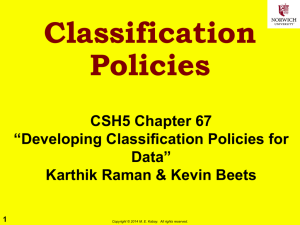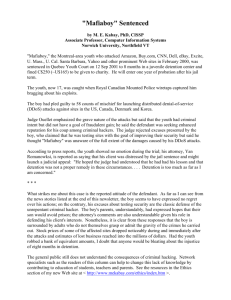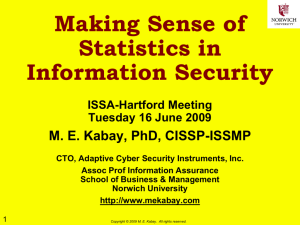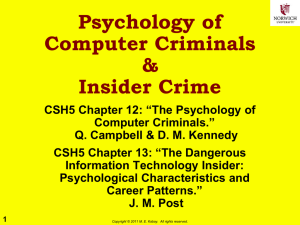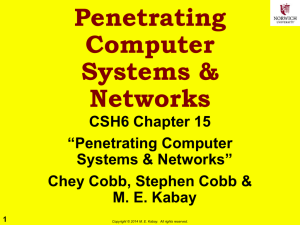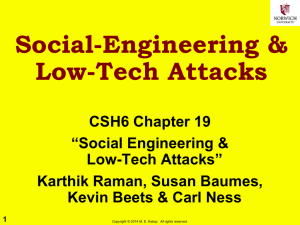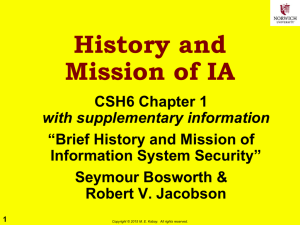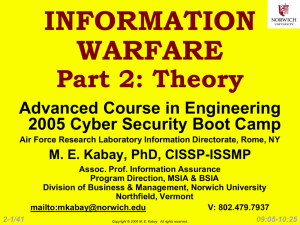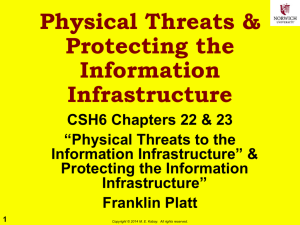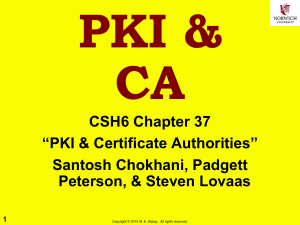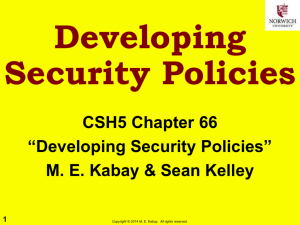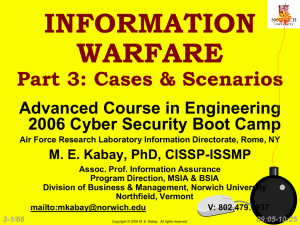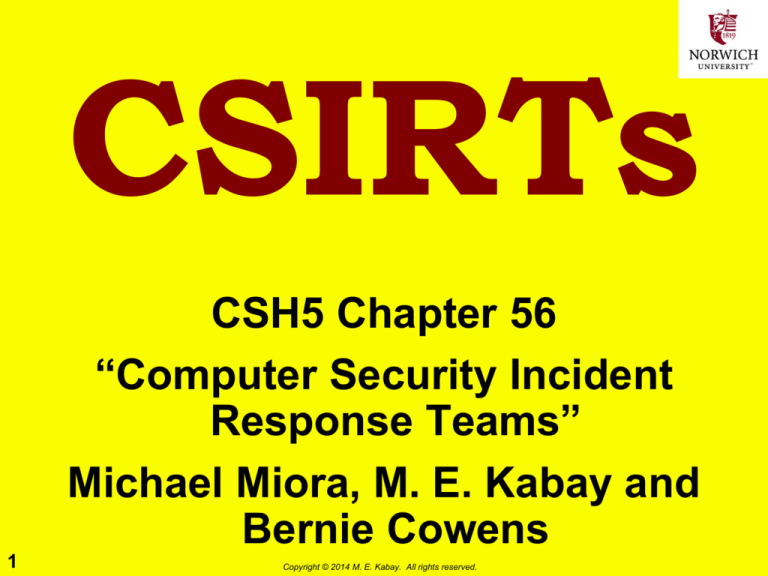
CSIRTs
CSH5 Chapter 56
“Computer Security Incident
Response Teams”
Michael Miora, M. E. Kabay and
Bernie Cowens
1
Copyright © 2014 M. E. Kabay. All rights reserved.
Topics
Forming a Team
Handling Computer Security Incidents
Managing a Team
2
Copyright © 2014 M. E. Kabay. All rights reserved.
Synonyms
CERT: Computer Emergency Readiness
Team (or also generically computer
emergency response team)
CSIRTs = Computer Security
Incident Response Teams
CIRTs (computer incident response teams)
Computer emergency quick-response
teams
3
Copyright © 2014 M. E. Kabay. All rights reserved.
DISA CIRTM CD-ROM
Assigned for individual study:
Computer Incident Response Team
Management*
• From Defense Information Systems Agency.
Topics
• Distributed at all possible
opportunities to get rid of them!
Forming a Team
Handling Computer Security Incidents
Managing a Team
Permission granted by DISA for free
duplication
May download entire CD-ROM in ZIP file:
http://www.mekabay.com/infosecmgmt/disa_cirtm_cdrom.zip
See also CSIRT Management monograph:
http://www.mekabay.com/infosecmgmt/csirtm.pdf
4
Copyright © 2014 M. E. Kabay. All rights reserved.
Forming & Constituting a
CSIRT
Overview
Incident
Response Arena
Typical Network
Attack
Services
Service Levels
Policies and
Procedures
Staff
5
Copyright © 2014 M. E. Kabay. All rights reserved.
Overview of this Section
The incident-response arena: why do we
need a CSIRT?
Steps in typical network attack
Reactive and proactive CSIRT services
Factors to consider in determining services
Policies and procedures for managing
incident response team
Knowledge, skills & abilities of personnel –
considerations when hiring staff
6
Copyright © 2014 M. E. Kabay. All rights reserved.
Incident Response Arena
Internet a global network with hundreds of
millions of potential attackers
IPv4 has limited provisions for security
Vulnerabilities & exploits change constantly
Systematic vulnerability scanning
Automated attack vectors
Protocol flaws
Buffer overflows….
7
Copyright © 2014 M. E. Kabay. All rights reserved.
Typical Network Attack
Motives vary;
economic
motivation growing
Intruders often
study system to
obtain root
Conceal evidence
by tampering with
log files
Install rootkits to
allow later access
Add to botnets for
spam or denial of
service
http://tinyurl.com/3dd2vq
8
Copyright © 2014 M. E. Kabay. All rights reserved.
Services
Computer Security Incident Response
Teams (CSIRTs)
Some organizations use “Computer
Emergency Response Teams” (CERTs)
CERT-CC® http://www.cert.org/
Computer Emergency Response
Team Coordination Center
Software Engineering Institute (SEI)
Carnegie-Mellon University (CMU)
Created in Dec 1988 in response to
problems in coping with Morris
Worm disaster of Nov 2, 1988
Must define services clearly to avoid
wrong expectations
9
Copyright © 2014 M. E. Kabay. All rights reserved.
Service Levels
Decide when CSIRT will be available
Normal work hours
Extended hours
24/7 coverage
Don’t announce
services until you can
actually provide them
Setting false
expectations will lead
to disaster
10
Copyright © 2014 M. E. Kabay. All rights reserved.
Policies and Procedures
Need written policies &
procedures (P&P)
Team can support CSIRT
mission
Set expectations for
confidentiality
Framework for normal
operations
Maintain consistent,
reliable service
Need leadership approval
and visible support
11
Copyright © 2014 M. E. Kabay. All rights reserved.
Staff Requirements
People are central to success
Good customer-service skills
Strong desire to resolve
problems
Handle distraught persons
calmly – get maximum info
Communicate clearly
Good oral/written
communication skills
Team work
Technical knowledge
Formal training in computer science
Related work experience
Coding skills
12
Copyright © 2014 M. E. Kabay. All rights reserved.
Screening Job Candidates
As discussed in Chapter 45 of CSH5
Interview
Position overview
Customer service orientation
Character
Pager, travel requirements
Flexibility in scheduling
Orientation and formal training
Mission
Policies & procedures
Specific problem-tracking tools
Diagnostic tools
13
Copyright © 2014 M. E. Kabay. All rights reserved.
Topics
Forming a Team
Handling Computer Security Incidents
Managing a Team
14
Copyright © 2014 M. E. Kabay. All rights reserved.
Handling Computer Security
Incidents
Types of Attacks
Computer Security Tools
Triage Process
Technical Requirements
Tracking System
Information & Response
Needs
Telephone Hotline
15
Copyright © 2014 M. E. Kabay. All rights reserved.
Types of Attacks
As discussed in CSH5 Chapter 8
Extent of damage can vary
Annoying to life-threatening
Evaluate costs of different types of incident
Types of attack
Penetration
Denial of service
Means
Automated attack
tools
Trojans
Viruses
Not possible to have a rigid framework in advance
16
Copyright © 2014 M. E. Kabay. All rights reserved.
Computer Security Tools
Learn about specifics
available to your CSIRT
General classes
I&A and related attacktools (e.g., cracks…)
Firewalls vs scanners
for vulnerabilities
Protocol-related attacks
Diagnostic tools
Debug
Dump analysis
Disk-editors
Sniffers
17
Copyright © 2014 M. E. Kabay. All rights reserved.
Triage Process
Must be able to allocate limited resources wisely
Triage name applied in medicine
Means “sorting” in French
Rapidly decide
Where to send callers for help
Which resources to assign to
specific problems
Identify critical-path relations
Look for problems that
potentially risk most severe
consequences
Functional analysis that must take into account
characteristics of each organization
18
Copyright © 2014 M. E. Kabay. All rights reserved.
Prioritizing Incidents
Sensitivity and/or criticality of the data affected
Amount of data affected
Which host machines are involved
Mission-critical
Where and under what conditions
the incident occurred
Effects of the incident on mission
accomplishment
Whether the incident is likely to
result in media coverage
Number of stakeholders affected
Possible relationships to other
incidents currently being investigated
The nature of the attack
Economic impact and time lost
Number of times the problem has recurred
Who reports the incident
19
Copyright © 2014 M. E. Kabay. All rights reserved.
Technical Requirements
Assign least-skilled staff to
triage stage – enough skill to
Identify nature of problem
Collect basic information
Decide quickly to whom to
send caller
Let more experienced
staff avoid clerical
functions
Information requests: low to
medium skill levels
Incident response: medium
skill levels
Vulnerability handling: high
skill levels
20
http://www.summum.us/images/jpg/pyramid3.jpg
Copyright © 2014 M. E. Kabay. All rights reserved.
Tracking System (1)
Critically important to track
information
Use formal tracking system (many
products available) to ensure
Easy notes
Availability to entire group
Keyword and full-text retrieval
Status settings
May play crucial role in solving
problems
For course notes on a course
taught in the 1980s and 1990s
about managing technical-support
issues, see
http://www.mekabay.com/courses/academic/jac/TS
P/index.htm
21
http://tinyurl.com/3xsued
Used with permission of the photographer,
Mike Robinson. See catalog at
http://tinyurl.com/3dm33c
Copyright © 2014 M. E. Kabay. All rights reserved.
Tracking System (2)
See
http://www.mekabay.com/methodology/Todo_empty.mdb
22
Copyright © 2014 M. E. Kabay. All rights reserved.
?
?
?
?
?
?
23
Information & Response Needs
for Every Incident Report
Who is the reporting organization?
What other organizations are involved or need to
know about the incident?
What is the date and time of the incident?
What type of incident is it?
What is the name or ID of the information system
or systems affected?
What is the mission impact of the incident?
What are the technical details or the who, what,
when, where, why, and how of the incident?
What actions have been taken?
Has there been any coordination with other
commands on the incident?
Are there any other clues or is any information
missing?
Copyright © 2014 M. E. Kabay. All rights reserved.
Telephone Hotline
Must handle phone calls at all times of day/night
Call-forwarding to agent on duty
Pagers
Message service
SMS to cell phones
Answering machine / voicemail()
Define rules for taking details and
then transferring calls to right person
MOST IMPORTANT:
Never drop the caller! Always monitor the transfer and
ensure there is a live person (not voicemail) on the other
end of the line to take control of the situation
Always provide direct-line phone #
& case # for use in case of interruption
Define procedures to handle cranks/pranks
24
Copyright © 2014 M. E. Kabay. All rights reserved.
Topics
Forming a Team
Handling Computer Security Incidents
Managing a Team
25
Copyright © 2014 M. E. Kabay. All rights reserved.
Managing a Team
Securing Your CSIRT
Using a Code of Conduct
Prioritizing Incidents
Balancing Workload
26
Copyright © 2014 M. E. Kabay. All rights reserved.
Securing Your CSIRT
CSIRT itself an attractive target for
attackers
Operational and legal repercussions to
compromise
Must protect
Incident reports,
Electronic mail,
Vulnerability reports,
and even
Briefing notes and
slides.
ENCRYPT ENCRYPT ENCRYPT…
BACKUP BACKUP BACKUP…
ENIGMA
27
http://www.swehs.co.uk/docs/photos/bletchley03.jpg
Copyright © 2014 M. E. Kabay. All rights reserved.
Using a Code of Conduct
Code of Conduct can determine reputation of team
Clear explanations
Define technical terms
Clarify work you plan to do
Never emit bovine fecal material: instead, try “I
don’t know but I’ll find out” – perfectly acceptable
response to a question
Establish continuous process
improvement by welcoming
constructive criticism and
suggestions for improvement
Maintain confidentiality
Support ethical behavior at all
times by all staff members
28
Copyright © 2014 M. E. Kabay. All rights reserved.
Balancing Workload in Triage
Handling new calls
Periodic rotation:
All new incidents are assigned to a
designated triage coordinator
At set intervals, incidents are
rotated to new triage coordinators
Equal distribution
Team leader reviews all new
reports
Distributes them evenly to staff
members
Combination approach
New reports distributed equitably
during regular hours
Outside regular hours rotate
periodically among coordinators
29
Copyright © 2014 M. E. Kabay. All rights reserved.
Dispatch
Primary
Escalation
Balancing Workload (cont’d)
Approaches to ongoing incidents
Single coordinator for entire incident
Develop stronger rapport with client
No lag time for turnover to next coordinator
Periodic hand off
Open incidents handed off to a new lead
person at regular intervals
Lag time but fresh perspective with each
hand-off
Combination approach common
Single coordinator takes lead for a given case
Hand it off to another team member when
necessary
30
Copyright © 2014 M. E. Kabay. All rights reserved.
Review Questions (1)
1. What is a computer security incident?
2. Why do we need a CSIRT?
3. When was the CERT-CC® formed and in response
to what incident?
4. Why should we define the working hours for our
CSIRT unambiguously?
5. How do written policies and procedures support
the functions of the CSIRT?
6. Why should we staff the CSIRT with people who
are NOT classic stereotyped geeks?
31
Copyright © 2014 M. E. Kabay. All rights reserved.
Review Questions (2)
7. Why (i.e., how) is triage a critically important
element of incident response team planning?
8. Why (i.e., how) are tracking systems valuable for
CSIRTs?
9. Why should the telephone hotline include
instructions that no caller is to be sent to another
resource without ascertaining that the transfer
has actually taken place (e.g., “Sally, this is Joe.
He will take over from this point. Here you go,
Joe.”)
10.Explain how a clear code of conduct can support
the functions of the CSIRT.
32
Copyright © 2014 M. E. Kabay. All rights reserved.
DISCUSSION
33
Copyright © 2014 M. E. Kabay. All rights reserved.


